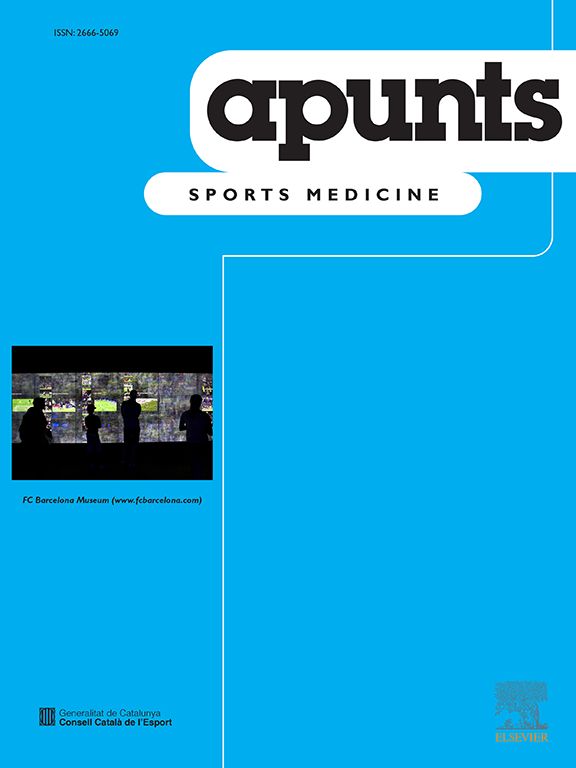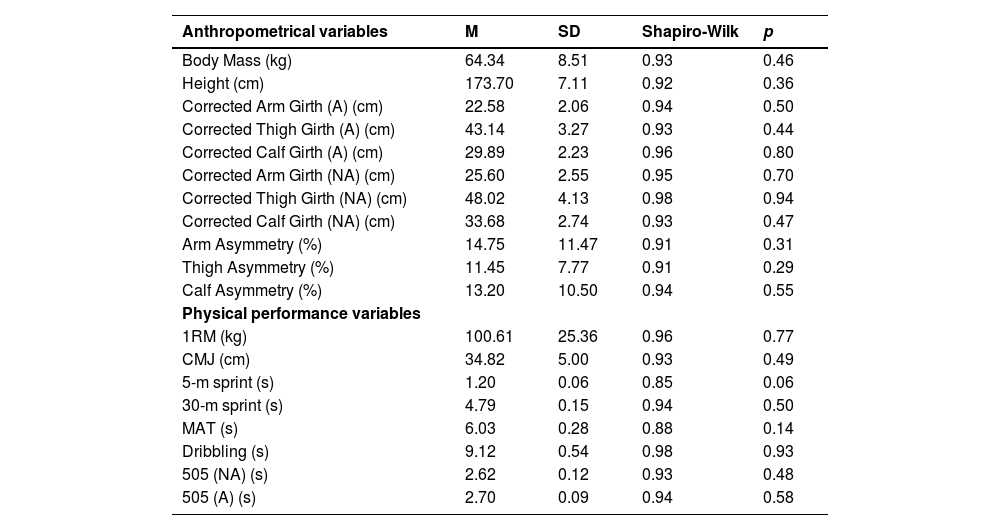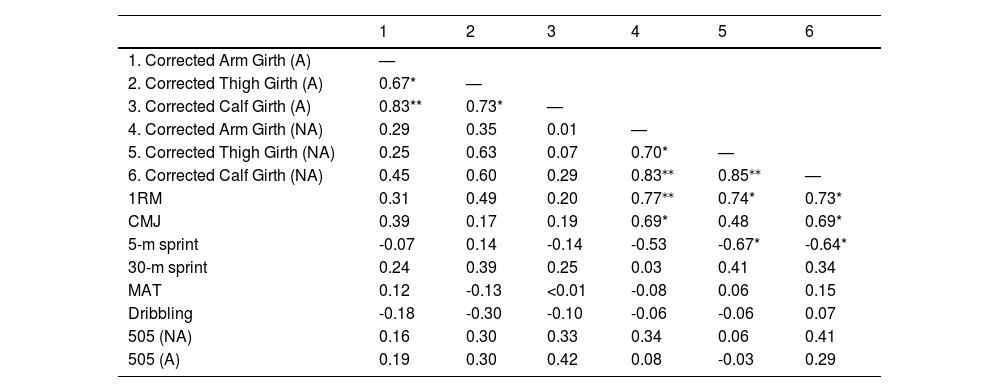This study aimed to analyze the association between the inter-limb anthropometric differences in ten international cerebral palsy football players with spastic hemiplegia and their physical performance.
Materials and methodsAnthropometric assessment included measurements for both limbs following ISAK protocols. Physical performance tests included 1RM strength, CMJ, 5-m and 30-m sprints, an agility test, a dribbling test, and the 505 change of direction test.
ResultsNo significant correlations were observed between anthropometric asymmetries and physical performance. Conversely, significant correlations were found between the girths of the unaffected limbs and 1RM (r= 0.73–0.77), CMJ (r= 0.69), and 5-m sprint (r= 0.64–0.67). Regression analysis identified the girth of the unaffected thigh and calf as predictors for 1RM (R²= 55%) and CMJ (R²= 48%), respectively.
ConclusionAlthough inter-limb asymmetries did not correlate with reduced performance, players relied on unaffected limbs, highlighting the role of compensatory strategies and targeted training in optimizing performance for CP football players.
The assessment of body composition and anthropometrical characteristics of athletes are important factors related to sports performance, which among key factors such as technical, tactical, and physical parameters are determinants to face the demands of the competition.1,2 Specifically in football, anthropometrical parameters are highly assessed as it has been considered a key element in the general performance of players, even showing differences according to position in the field.3 For instance, variables such as body composition, muscle mass, and height have been linked to improved strength, speed, and endurance, which are essential for higher levels of performance in football.4 Particularly, individuals with cerebral palsy (CP) and related health conditions can compete in an adapted football modality (i.e., CP Football) that has similarities with their able-bodied counterparts in physical, technical, and tactical demands.5 Para-athletes with CP present neurological impairments that can produce motor involvement that affects the mechanical and physiological properties of muscle, having multiple consequences in motor actions, including those related to sport performance.6,7 One of the most frequent topographical consequences of CP is spastic hemiplegia affecting one side of the body with neural (i.e., spasticity, clonus, hyperreflexia) and non-neural (i.e., weakness, poor selective motor control, contractures) features.8,9 Furthermore, spastic hemiplegia is one of the predominant profiles in CP football representing around 60% of the total population practicing CP football worldwide,10 making it a primary focus for researchers and professionals in this sport to understand the impact this profile has on sport performance. The presence of spastic hemiplegia introduces significant body asymmetries, both in terms of anthropometric parameters and physical performance capabilities. Studies have shown that athletes with spastic hemiplegia often exhibit marked differences in muscle mass, skinfold thickness, and limb girths between the affected and non-affected sides, contributing to an overall asymmetry in body composition.11
In the field of CP football, it is coherent to assume that it will prevail similar associations such as the able-bodied football between anthropometrical features and physical performance parameters since players with and without CP or acquired brain injury (ABI) can be considered with homogeneous profiles (i.e., when the dominant side is assessed).11,12 However, Doménech et al. (2023) reported that players with spastic hemiplegia presented differences in anthropometrical parameters between dominant and non-dominant sides, except for the trunk skinfolds. Previous studies in able-bodied athletes have also suggested that greater anthropometric asymmetries, such as differences in muscle mass and fat distribution between limbs, are associated with reduced performance in tasks requiring speed and power, highlighting the importance of addressing these discrepancies in sports training.13,14 Possibly, Interlimb asymmetries could negatively impact performance in sport-specific tasks like change of direction, sprinting, and jumping by impairing coordination, speed, and agility, highlighting the importance of targeted training and rehabilitation for athletes with spastic hemiplegia.12,15
Players with spastic hemiplegia have shown significant differences in anthropometric variables between sides (affected vs. non-affected side),12 which challenges the presumed relationship between anthropometric variables and physical performance described in able-bodied population. Nonetheless, the specific impact of body asymmetries caused by spastic hemiplegia on the physical performance of international CP football players has not been previously studied. Given that asymmetries between limbs in parameters such as range of motion or strength have been shown to negatively affect performance in football players without disabilities,16,17 it could be hypothesized that greater asymmetries caused by CP would lead to a more significant decline in physical performance. Therefore, this study aimed to evaluate the inter-limb anthropometric differences of international CP football players, and to analyze the relationship of these anthropometric variables with physical performance.
Materials and methodsParticipantsTen male international CP football players (body mass: 65.2 ± 7.6 kg; height: 174.9 ± 7.2 cm) internationally classified as FT2 participated in this study (see descriptive data in Table 1). The inclusion criteria required participants to have an active license with the Spanish Sport Federation for People with Cerebral Palsy (FEDPC), to be regularly involved with the national team (with a minimum of one participation in an international competition), to be injury-free at the time of assessment and in the preceding weeks, and to have a medically confirmed diagnosis of spastic hemiplegia. Specifically, players had to be free of any muscle soreness or minor injuries in the two weeks prior to assessment, and none of them had suffered moderate or severe injuries (e.g., muscle tears) during the entire season. Two of the players were under medication for epilepsy; however, they had been seizure-free for at least five years, and the medication did not affect their physical performance. All participants provided written consent after receiving a detailed explanation of the study risks and benefits. The study was approved by the ethics committee of the host institution (ADH.DES.IPG.JFM.24).
Descriptive data of the anthropometrical and physical performance variables of international players with cerebral palsy.
RM: Repetition Maximum; CMJ: Countermovement Jump; MAT: Modified Agility Test; 505: Change of Direction Test; A: affected side; NA: non-affected side.
The assessments were conducted during the team's first training camp of the season, corresponding to the pre-competitive period. All measurements were made following the guidelines stated by the International Society for the Advancement in Kineanthropometric (ISAK).18 The limb measurements were obtained for both body sides in all the participants and taken in duplicate. An average of the two measurements was recorded. The total body mass and height of each participant were measured using a Tanita digital scale (Bc 601 Ltd., Japan ± 0.1 kg), height with a fixed stadiometer (SECA Ltd., Germany ± 0.1 cm), girths with a metallic nonextensile tape (Lufkin, Sparks, NV, USA), and skinfolds with a Holtain Tanner/Whitehouse skinfold caliper (Holtain, Crosswell, UK). The following three girths were measured: relaxed arm; thigh; and medial calf. Finally, three skinfolds were also measured: triceps (Tr); thigh (Th); and medial calf (Ca). In addition, the corrected arm, thigh, and calf were calculated using the formula (1):
Physical performance assessmentRepetition maximum (RM)The one-repetition maximum strength (1RM) in the half-squat exercise was estimated indirectly, based on the movement velocity, according to the recommendations of González-Badillo.19 The protocol was performed in a Smith Machine (Technogym Trading, Gambettola, Italy) and the movement velocity was recorded with a linear encoder (Chronojump BoscoSystem®, version 1.6.2, Spain).
Countermovement jump (CMJ)The vertical jump capacity of players was assessed through the CMJ test using a contact platform (Globus Ergotester®, Italy). Players performed two repetitions with one minute of rest between them, and the best height was used for further analysis. Players were allowed to perform the CMJ with an arm swing, as in some cases, their disability did not allow them to keep one hand on the hip during the entire test, or it distorted the movement pattern.
5-m and 30-m linear sprintTo the assessment of the players’ acceleration and running velocity, the participants performed a 30-m linear sprint. The time during the 5 and 30-m was registered using a photocell system (Witty System, Microgate, Bolzano, Italy). Players started in a standing position behind the starting line and performed two repetitions of the sprint with two minutes of rest. The best attempt was recorded for further analysis.
Modified agility test (MAT)The modified version20 of the original MAT from Sassi et al. (2009) was used to assess the player’s change of direction ability.21 Players performed two attempts of the test with two minutes of rest, and the best one was used for further analysis. The time in the test was registered using a photocell system (Witty System, Microgate, Bolzano, Italy).
DribblingThe same structure of the MAT was maintained for the dribbling ability assessment.20 Players perform two attempts of this test dribbling the ball with two minutes of rest, and the best attempt was recorded for the analysis. The time spent in the performance of this dribbling test was registered using a photocell system (Witty System, Microgate, Bolzano, Italy).
TestThe 505 test was used to assess the change of direction ability of players with a single leg.7 In this test, players must perform a 180° change of direction using a single leg. This test was carried out twice with each leg, with two minutes of recovery and the best time with each leg was recorded for further analysis. The time was recorded with the photocell system (Witty System, Microgate, Bolzano, Italy).
All players performed the tests in the same order and wore their usual sportswear and football boots for the field tests. The 1RM and CMJ tests were conducted on the first day of assessment, after the anthropometric assessment. The field tests -linear sprint, MAT, dribbling, and 505 tests- were conducted on the second day of assessment on a synthetic grass field. Throughout all tests, players were encouraged to perform at their maximum effort and velocity.
Statistical analysisA normality analysis was conducted using the Shapiro-Wilk test, which demonstrated that all variables included in the analysis followed a parametric distribution. The Pearson's correlation coefficient (r) analysis was used to examine the relationship between player’s anthropometrical variables and their physical performance. Pearson’s correlation coefficients were interpreted following the guidelines of Hopkins et al. (2009) as trivial (< 0.09), small (0.10–0.29), moderate (0.30–0.49), high (0.50–0.69), very high (0.70–0.89), and almost perfect (>0.90).22 A multiple linear regression analysis was conducted using the "stepwise" method, using each physical performance test as a dependent variable, and introducing all anthropometrical parameters (i.e., perimeters and asymmetries) as possible predictors. All analyses were performed using dedicated spreadsheets in Microsoft Excel (Microsoft, Seattle, USA) and JASP (JASP for Windows, version 0.13, Amsterdam, Netherlands). The level of statistical significance to reject null hypotheses was set at p < 0.05.
ResultsThe average values of the anthropometric and physical performance variables of the sample, along with the results of the Shapiro-Wilk test, are presented in Table 1, indicating that the data follows a normal distribution for all analysed variables. Correlational analyses results are presented in Table 2. The results revealed no correlation between the girths of the affected arm, thigh, and calf with any of the physical performance assessment tests (r = <0.01 – 0.53; p > 0.05). These same analyses demonstrated a correlation between players' maximum squat force production (1RM) and the girths of their unaffected arm, thigh, and calf (r = 0.73 - 0.77; p = 0.01 - 0.02; very high). Additionally, a correlation was found between the CMJ and the girths of the unaffected arm and calf (r = 0.69; p = 0.03; high), as well as between the 5-m sprint time and the girths of the unaffected thigh and leg (r = 0.64 - 0.69; p = 0.03 - 0.04; high). No correlation was observed between any girths on the unaffected side and the rest of the physical performance variables.
Pearson's correlations results between anthropometrical data and physical performance tests.
| 1 | 2 | 3 | 4 | 5 | 6 | |
|---|---|---|---|---|---|---|
| 1. Corrected Arm Girth (A) | — | |||||
| 2. Corrected Thigh Girth (A) | 0.67* | — | ||||
| 3. Corrected Calf Girth (A) | 0.83** | 0.73* | — | |||
| 4. Corrected Arm Girth (NA) | 0.29 | 0.35 | 0.01 | — | ||
| 5. Corrected Thigh Girth (NA) | 0.25 | 0.63 | 0.07 | 0.70* | — | |
| 6. Corrected Calf Girth (NA) | 0.45 | 0.60 | 0.29 | 0.83⁎⁎ | 0.85⁎⁎ | — |
| 1RM | 0.31 | 0.49 | 0.20 | 0.77⁎⁎ | 0.74* | 0.73* |
| CMJ | 0.39 | 0.17 | 0.19 | 0.69* | 0.48 | 0.69* |
| 5-m sprint | -0.07 | 0.14 | -0.14 | -0.53 | -0.67* | -0.64* |
| 30-m sprint | 0.24 | 0.39 | 0.25 | 0.03 | 0.41 | 0.34 |
| MAT | 0.12 | -0.13 | <0.01 | -0.08 | 0.06 | 0.15 |
| Dribbling | -0.18 | -0.30 | -0.10 | -0.06 | -0.06 | 0.07 |
| 505 (NA) | 0.16 | 0.30 | 0.33 | 0.34 | 0.06 | 0.41 |
| 505 (A) | 0.19 | 0.30 | 0.42 | 0.08 | -0.03 | 0.29 |
RM: Repetition Maximum; CMJ: Countermovement Jump; MAT: Modified Agility Test; 505: Change of Direction Test; A: affected side; NA: non-affected side.
Table 3 displays the correlations between asymmetries and physical performance, showing a significant correlation between the 5-m sprint time and the players' asymmetry percentage in the thigh (r = 0.67; p = 0.03; high) and calf (r = 0.69; p = 0.02; high). The multiple linear regression analysis identified the girth of the unaffected thigh as a predictor of 1RM (β = 0.74; p = 0.01; R2 = 55%), the girth of the unaffected calf as a predictor of CMJ (β = 0.69; p = 0.03; R2 = 48%), and the percentage of asymmetry between calves as a predictor of the 5-m sprint (β = 0.69; p = 0.03; R2 = 48%) (Table 4). The analysis did not establish any other prediction models for the remaining physical performance variables.
Pearson's correlations results between anthropometrical asymmetries and physical performance tests.
| Variable | 1 | 2 | 3 |
|---|---|---|---|
| 1. Arm Asymmetry (%) | — | ||
| 2. Thigh Asymmetry (%) | 0.79⁎⁎ | — | |
| 3. Calf Asymmetry (%) | 0.85⁎⁎ | 0.93⁎⁎ | — |
| 1RM | 0.44 | 0.41 | 0.47 |
| CMJ | 0.31 | 0.43 | 0.48 |
| 5-m sprint | 0.57 | 0.67* | 0.69* |
| 30-m sprint | -0.08 | 0.08 | 0.13 |
| MAT | -0.13 | 0.17 | 0.17 |
| Dribbling | 0.12 | 0.21 | 0.17 |
| 505 (NA) | 0.18 | -0.19 | 0.13 |
| 505 (A) | -0.05 | -0.31 | -0.04 |
RM: Repetition Maximum; CMJ: Countermovement Jump; MAT: Modified Agility Test; 505: Change of Direction Test; A: affected side; NA: non-affected side.
Multiple linear regression analysis results between anthropometrical asymmetries and physical performance tests.
RM: Repetition Maximum; CMJ: Countermovement Jump; MAT: Modified Agility Test; 505: Change of Direction Test; A: affected side; NA: non-affected side.
This study examined the relationship between inter-limb anthropometric asymmetries and physical performance in international footballers with spastic hemiplegia. One of the main findings of this study is that, contrary to the general expectation that large asymmetries would negatively impact physical performance, there were no significant correlations between the anthropometric inter-limb asymmetries and physical performance. This suggests that the presence of notable asymmetries does not necessarily correlate with reduced performance in this population. On the other hand, there was a notable association between the physical performance and the non-affected side, suggesting that players may rely more heavily on this side to compensate during physical tasks. This implies that performance variables might be more influenced by the contribution of the non-affected limb. These interesting results suggest that hemiplegic sport population have adaptative movement patterns and compensatory muscular strategies, probably developed from a young age, and based on the ability of the non-affected side.23 These adaptations may enable them to achieve high-performance levels, effectively mitigating the negative impact of their asymmetries.24
In sports, particularly in football, asymmetries are commonly assessed through strength tests, which provide insights into muscle imbalances and their potential effect on performance.25 Previous research with able-bodied players has demonstrated that strength asymmetries between limbs are often linked to decreased performance in activities requiring power, speed, and agility, such as sprinting, jumping, and changing direction.16,26,27 These findings are consistent with previous research in sports for individuals with CP, particularly when examining inter-limb performance and its association with key physical performance variables relevant to football.15 In football, given its dynamic and asymmetrical nature, where players frequently engage in explosive movements and rapid directional changes, balanced strength across limbs is critical to optimizing performance.28 However, most of the existing research focuses primarily on strength asymmetries or other inter-limb physical capacities rather than anthropometric differences, particularly among footballers or athletes with impairments.6,10,24,29–31
The lack of significant correlations between the girths of the affected limbs and performance measures in our study may indicate that footballers with spastic hemiplegia develop unique compensatory movement patterns and muscular strategies that allow them to maintain effective performance despite their asymmetries. This aligns with previous research indicating that players with CP, including those with hemiplegia, can develop adaptations that enable them to perform effectively in sport-specific tasks.10,15,24 These adaptations could involve optimizing the use of their unaffected side, modifying their mechanics to accommodate for asymmetry, or developing neuromuscular strategies that enhance overall performance, thereby reducing the potential negative impact of asymmetries.24,32,33 Although it has been shown that football players with cerebral palsy—regardless of their impairment profile (spastic hemiplegia, spastic diplegia, or athetoid/ataxic forms)—develop motor adaptation mechanisms to optimize performance,24,32,33 it is hypothesized that these compensatory strategies may differ across profiles due to the distinct ways in which each type of impairment affects motor function.
Conversely, our study found significant correlations between the girths of the unaffected limbs and performance metrics, such as 1RM, CMJ, and 5-m sprint time. This suggests that players with spastic hemiplegia may rely on their unaffected side to optimize overall performance, compensating for the limitations of their affected side. This finding is consistent with studies that have shown how individuals with unilateral impairments can maximize the use of their unaffected side for tasks requiring strength and power.34,35 These compensatory strategies likely involve increased reliance on the unaffected side for power generation, stability, and control during explosive movements, which could counterbalance the limitations imposed by the asymmetries of the affected side.24
The results of the present study also diverge from findings in able-bodied populations, where anthropometric asymmetries, such as differences in limb girth and muscle mass, have been linked to altered running mechanics, reduced jump performance, and an increased risk of injury.14,36–38 The absence of similar correlations in our study highlights the importance of considering the specific context of CP footballers when interpreting the effects of asymmetries on performance. It also raises the possibility that the unique adaptations of CP footballers may mitigate some of the negative effects of asymmetry that are observed in other populations. These findings align with early studies which found that hemiplegic footballers with CP exhibit significant differences between impaired and non-impaired legs during performance tests that require substantial muscle power and coordination, such as the triple hop test and balance activities.10,39 In the present study, the predictive power of thigh and calf asymmetry for 5-m sprint time further supports the idea that asymmetries influence performance, but the degree of this influence is moderated by compensatory mechanisms developed by players. As observed in the able-bodied population, asymmetries also appear to vary among individuals with CP and the interpretation of this data requires consideration of the individual nature of this parameter and the potential influence of impairments (i.e., the severity of the impairment causing the asymmetry).31,40
These results also underscore that the impact of asymmetries may vary depending on the severity of impairment and the nature of the physical task which may impact the results of the present study.40 Possibly, players with more severe impairments could show greater inter-limb differences, particularly in tasks involving explosive power and speed, reflecting findings in able-bodied players, where increased asymmetry often correlates with decreased performance.16,41 Conversely, players with milder impairments may benefit from more symmetrical use of both limbs, likely due to their higher proficiency and lower levels of neurological impairment, which enable more balanced neuromuscular function.42 These differences across player profiles and sport classes highlight the importance of considering impairment-specific factors when analyzing performance in footballers with CP. For example, players with unilateral spasticity (as the hemiplegic profile shown in this study) might show more pronounced inter-limb differences than those with bilateral spasticity (i.e. diplegia) or coordination impairments. This difference could be attributed to the neural and non-neural mechanisms that increase resistance to motion in people with spastic profiles,43 as well as to the compensatory strategies that players with CP develop in response to their specific impairment topographies.9
The practical implications of our findings are significant for coaches and classifiers who allocated players in sport classes according to the impact of the impairment to ensure a fair game in CP football. Understanding the variability in inter-limb asymmetries and their potential compensatory effects is crucial for designing training programs and making informed decisions about player classification. While strength training showed beneficial to improve balancing inter-limb capacities,30,44 attention should also be given to enhancing coordination, agility, and power generation in both affected and unaffected limbs to improve overall performance. Future research should explore how training interventions targeting weaker limbs or specific compensatory strategies could impact asymmetry and performance over time. In addition, future studies should also consider player sport classes and the extent of impairment impact. Unilateral assessments are particularly valuable for differentiating between sport classes and impairment profiles, as they provide detailed insights into the functional capacity of each limb, eliminating biases that may arise from bilateral tests.15,45 Some limitations of this study should be noted when interpreting the data. The sample is restricted to players with hemiplegia, despite the diverse spectrum of CP, which includes profiles such as diplegia or coordination impairments that are also represented in para-sports. In addition, the sample size was limited to only ten participants; however, it is important to highlight that these ten players represented 100% of the national pool of international-level footballers with spastic hemiplegia in the country, making the sample highly representative of this specific population.
In conclusion, while it is generally assumed that large anthropometric asymmetries negatively affect physical performance, our findings suggest that footballers with spastic hemiplegia may develop adaptive strategies that allow them to perform optimally despite these asymmetries. Coaches and classifiers should be aware that inter-limb differences in this population can vary significantly based on the specific physical assessment and impairment profile. This nuanced understanding is essential for optimizing training strategies and classification practices in CP football, ultimately enhancing performance and competitive fairness for players with neurological impairments.
The authors report there are no competing interests to declare.
The authors would like to thank the Spanish Federation of Sports for People with Cerebral Palsy and Acquired Brain Injury (FEDPC) for its collaboration in the present study.
The study was approved by the ethics committee of the host institution: DCD.IPG.060523










